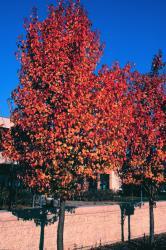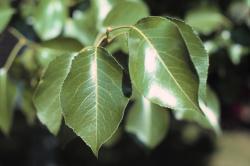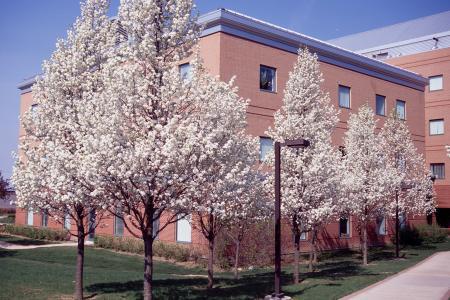June 11, 2013
| Pyrus calleryana cvs. Callery Pear
|
| Description | Callery Pear cultivars are widely popular for the lovely floral show each spring, compact size and pest resistance. Lovely bloom, glossy leaves, interesting fall colour, fast growth and urban tolerance maintain the appeal of this small tree. |
| Usage | Parking lot island, buffer strip, highway, shade tree, street tree. |
| Origin | Korea, China, Japan, Vietnam |
| Hardiness zone | 4,5 |
| Size | 11-13m |
| Form/texture | Broadly pryamidal, open, wide branch angles. |
| Growth rate | Fast. |
| Leaf | Dark lustrous green and wavy edge makes them showy, turning yellow to deep red in fall. |
| Flower | White, very showy in May. |
| Fruit | Small brown or tan, attracts birds, persistent. |
| Exposure/culture | Full sun. Tolerates very wet to very dry soils. Tolerates wide range of pH. Moderately tolerant salt spray (Beckerman et al, Morton). Pollution resistant. Easily transplanted. |
| Comments | With great urban tolerance and aesthetic appeal the Callery pear is a frequent choice for landscapes. Newer cultivars have improved on the widely planted but brittle and weak-wooded 'Bradford' (Gerhold). 'Aristocrat' is one of a few cultivars with strong branch arrangement and improved winter hardiness. Overuse of this tree has increased susceptibility to disease and to placement on the invasive lists of the U.S. (http://www.invasiveplantatlas.org/trees.html). Callery Pears are naturally self-sterile, but will readily cross-pollinate other cultivars. Control of existing trees is difficult due to resprouting (Culley et al). Restricting Callery pears to extreme urban spots where few others will grow may curtail the invasive threat. Choosing other trees where possible will improve the diversity of urban plantings. |
| Cultivar | Form | Disease | Fall colour | Other |
| Chanticleer (Cleveland Select) | Upright, narrow pyramid | Tolerant to fireblight | Gold-red to plum | Enters dormancy earlier than other cv's |
| Redspire | Pyramid to oval, dense, slow growing | Tolerant to fireblight | Yellow in fall | Many flowers Leaves thick shiny green |
| Autumn Blaze | Rounded, open, wide branch angles | Susceptible to fireblight | Early, reliable red | More right-angle branching than other cv's |
| Aristocrat | Broadly pyramidal, open | Slightly susceptible to fireblight | Yellow to deep red | Later bloomer, fewer but still showy flowers. Leaves have wavy margin |


Reference:
Bassuk, N., D. F. Curtis, B.Z. Marrance, and B. Neal. 2009. Recommended Urban Trees: Site Assessment and Tree Selection for Stress Tolerance. Urban Horticulture Institute. Ithaca, NY.
Beckerman, J. and B.R. Lerner. 2009. Salt Damage in Landscape Plants. Purdue Extension Publication ID-412-W. Purdue University. West LaFayette, IN.
Culley, T. M. and N. A. Hardiman. 2007. The Beginning of a New Invasive Plant: A History of the Ornamental Callery Pear in the United States. BioScience 57(11): 956-964.
Gerhold, H. D. 2007. Callery Pear Cultivars Tested as Street Trees: Final Report on a 12-Year Study. Arboriculture and Urban Forestry 33(2): 153-156.
Kuser, J. E., Robinson, G., and Polanin, N. 2001. Four-year evaluation of five cultivars of Pyrus calleryana. Journal of Arboriculture 27(2): 88-91.
Morton Arboretum Salt Tolerant Trees. Michigan State University Extension Service Publication, HM-95.
